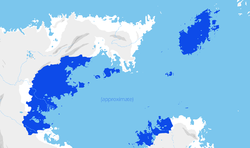Saruan Empire
| Neviran Empire in the Saru Sea | |||||
| |||||
The Saruan Empire at its greatest extent
| |||||
| Capital | Yisma | ||||
| Languages | Neviran languages, Lahiri languages, Ystelic languages, Sanu-Jutean languages | ||||
| Religion | Qurosism, Iovism, other faiths | ||||
| Government | Multidynastic militaristic autocracy | ||||
| Emperor | |||||
| • | 1611-1646 | Emperor 1 | |||
| Historical era | Colonial | ||||
| • | Proclaimed | June 27, 1611 | |||
| • | Dissolved | October 14, 1889 | |||
The Saruan Empire, ( Classical Neviran: Nivīxabā ēθehaqā, Modern Neviran: Sorixabo Athoqa ) also called the Neviran Saruan Empire or the Second Neviran Empire and, in previously occupied territories, often simply the Neviran Empire, was a colonial empire in mid-eastern Baredina, Lahan, northern Ystel, and many small islands in the Saru Sea. The spiritual successor to the First Neviran Empire, the Saruan Empire began as the consolidation of the Interimperial Neviran Region. New maritime technologies developed in Nevira and acquired from abroad allowed swifter and more economical exploration of the Saru sea and those landmasses which border it, which swiftly developed into speculative trade ventures and from there into colonial enterprises. It was administrated from modern Nevira and has had lasting cultural impacts on Povania, Lahan, Jute, South Jute and Mermelia. Probably.
Etymology
The Empire shared its name with Saru sea, whose coasts it generally conquered or had significant control over. However, the exact relationship between the name of the sea and that of the empire are disputed, with some linguists and historians stating that the sea was named for the Empire.
History
Rise
The fall of the First Neviran Empire as a result of overextension marked the policy of the delta state Jenneye in the aftermath of the first imperial collapse. As a new power vacuum suddenly opened across former imperial lands, the delta state centered on protecting its borders rather than starting offensive wars for expansion. Additionally, the military focus brought in the imperial era created a tradition of military commanders gaining more power in the imperial decision-making, something which lasted well onto the establishment of the Jenneye kingdom. The imperial dynasty in Yisma was weak, and was further weakened by political intrigue. The hereditary nature of the kingdom was questionable by the late 16th century, and in 1603 when king X died without an heir, a council composed of the nobility and military commanders convened to elect a new king, officially establishing the elective system.
The collapse difficulties trade at first, yet the delta cities easily regained their position as major trade centres in the Saruan sea.
It is unclear when the Saruan Empire was proclaimed, but lower ekuosian historiography considers that moment to be in 1611, after Emperor X proclaimed Nivīšabā Ēθehāqā (Neviran might) after the surrender, in the same day, of the besieged cities of Hazimde in central Nevira and Kizhavle in modern-day Cimseje.
Expansion
Neviran traders expanded their horizons, and after several land campaigns across modern Nevira and the Povan Union, the imperial policy shifted to a focus on the sea, as to avoid the mistakes commited by the first empire and avoid costly land expansions.
It reached Lahan in 1631 and formed alliances with some of the local dynasties, including the Kingdom of Thap and the Luyuan Confederacy, providing military technology and imported natural products in exchange for raw latex, vulcanized rubber products, and lucrative trade treaties.
Imperial frontiers remained somewhat constant in the mainland, with most of modern Nevira and Povania (except modern Arzahu secured. Colonial possessions were expanded during the mid 17th century in the island of X in modern Asesha and Lahan, in order to maintain a route to the Prime Corridor. Expeditions in Püzimm were avoided, unless it was to aid an allied state in the region.
The last expansion came in Ystel, where imperial interests had been present ever since the 17th century, but only in the first half of the 18th century was any Ystelian territory integrated into the empire.
Decline
Unlike the first empire, the downfall of the Saruan Empire did not come as a straightforward consequence of aggressive overexpansion.
Lahan had been the crown of all colonial possessions, and had carried a huge investment. However, imperial control of the continent was weak, and the extraction of raw materials, which was one of the main reasons the endeavour took place, was disrupted by several factors, such as the so called Rubber Barons, local oligarchs, siphoned away materials, pirates, and lacking infrastructure. Lahan became increasingly costly to operate each year, and as a result of other economical difficulties, it was decided that it would be sold to the Balak Empire.
The maritime nature of the empire made its revenue dependant on mostly trade in the Ekuos and the Saruan sea
Politics
Government
The Saruan Empire was governed from present-day Nevira by a monarch. Colonies and territories were officially overseen by members of the royal family or lesser nobles, but many were de facto ruled by the military leadership.
Administrative divisions
Foreign relations
Military
Economy
Science and technology
Demographics
Ethnic groups
Due to its imperial, colonial nature, the Saruan Empire was made up of many different ethnic groups, many of which had little or no relation to each other, and especially to the ruling class.
Urbanisation
Language
Classical Neviran was the administrative language and lingua franca of the Empire.
Education
Healthcare
Religion
The ruling classes of the Saruan Empire subscribed to various sects of Qurosism.

